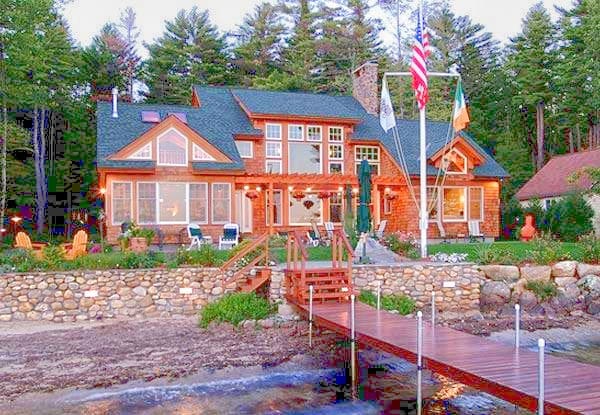If you own a timber frame or post and beam home that you use as a summer home, you may be getting ready to close up your property as the summer winds down. Before you leave the property for the season, you should prepare the house for the winter ahead. With proper preparation now, your home will be ready and inviting for the next summer season. Here are some of the most important tips on winterizing your home. 
Lake Winnipesaukee Timberpeg Home Designed by Tom Samyn and Ward D’Elia. Photo by Joe St. Pierre.
Shut Off Water
One of the best ideas for winterizing a house is to shut off the water before leaving for the season. While a well-insulated and heated house should prevent pipes from bursting, if your house is without power for extended periods of time then the lack of heat may cause pipes to fail. Furthermore, washing machine hoses are prone to catastrophic failure even at normal room temperature, so shutting off your water at the main is the best way to prevent major water damage while you’re away. After shutting off your water main and draining all supply lines, consider filling drain traps with propylene-glycol type antifreeze or sealing the drains altogether to prevent sewer gas from entering the home in case the trap water evaporates.
Turn Down the Thermostat
Since you will be away from the house, there is no need to heat the house to make it comfortable. The temperature should be high enough to keep the house safe; typically 55 degrees is hot enough for any house and well-insulated houses can leave the thermostat even lower. If your furnace has a humidity control function, make sure that it is enabled so the house doesn’t get too dry or damp. In order to keep the heat in and prevent any drafts, make sure the dampers are closed on all fireplaces in the house.
Unplug Electrical
Although you will be away, electricity will be required to run things like the furnace and sump pump. Nonetheless, cutting electricity to non-essential areas of the house is a good idea for safety sake. Although you can unplug cords from outlets, turning off non-essential breakers is a faster and better idea. You should leave the main and breakers for essentials like the furnace and pump closed, but breakers that supply the lighting, outlets, oven, dryer, etc. can be opened. Since you will be shutting off the refrigerator and removing all perishable food from the house, closing time is also a great time to clean the refrigerator, freezer, and pantry so they are fresh for use next season. 
Write Down a List for Reopening Time
While you attend to the items above this fall, make sure to record what needs to be done in the spring. For example, if you shut off the water and gas this fall, make a reminder to turn those services on again in the spring. This simple journal of what you need to do in the spring can spare you the frustration of remembering all the things you need to “undo” when you open the house again. Of course, if you don’t have a timber frame summer home on a lake, the coast or in the woods, and you’ve been thinking about building one, now is also a great time of year to get started. So, with careful planning, when it comes time to open the summer home next year, you’ll be ready to move in and enjoy.



